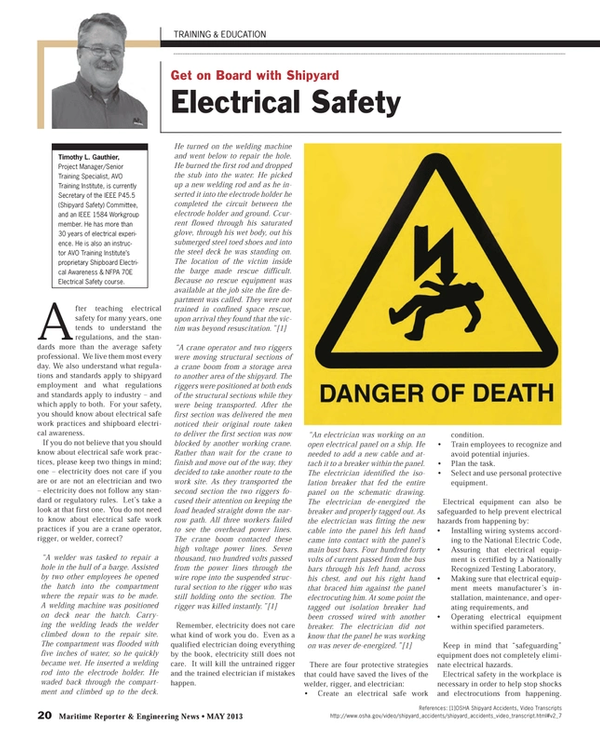
Get on Board with Shipyard Electrical Safety
After teaching electrical safety for many years, one tends to understand the regulations, and the standards more than the average safety professional. We live them most every day. We also understand what regulations and standards apply to shipyard employment and what regulations and standards apply to industry – and which apply to both. For your safety, you should know about electrical safe work practices and shipboard electrical awareness.
If you do not believe that you should know about electrical safe work practices, please keep two things in mind; one – electricity does not care if you are or are not an electrician and two – electricity does not follow any standard or regulatory rules. Let’s take a look at that first one. You do not need to know about electrical safe work practices if you are a crane operator, rigger, or welder, correct?
“A welder was tasked to repair a hole in the hull of a barge. Assisted by two other employees he opened the hatch into the compartment where the repair was to be made. A welding machine was positioned on deck near the hatch. Carrying the welding leads the welder climbed down to the repair site. The compartment was flooded with five inches of water, so he quickly became wet. He inserted a welding rod into the electrode holder. He waded back through the compartment and climbed up to the deck. He turned on the welding machine and went below to repair the hole. He burned the first rod and dropped the stub into the water. He picked up a new welding rod and as he inserted it into the electrode holder he completed the circuit between the electrode holder and ground. Ccurrent flowed through his saturated glove, through his wet body, out his submerged steel toed shoes and into the steel deck he was standing on. The location of the victim inside the barge made rescue difficult. Because no rescue equipment was available at the job site the fire department was called. They were not trained in confined space rescue, upon arrival they found that the victim was beyond resuscitation.”[1]
“A crane operator and two riggers were moving structural sections of a crane boom from a storage area to another area of the shipyard. The riggers were positioned at both ends of the structural sections while they were being transported. After the first section was delivered the men noticed their original route taken to deliver the first section was now blocked by another working crane. Rather than wait for the crane to finish and move out of the way, they decided to take another route to the work site. As they transported the second section the two riggers focused their attention on keeping the load headed straight down the narrow path. All three workers failed to see the overhead power lines. The crane boom contacted these high voltage power lines. Seven thousand, two hundred volts passed from the power lines through the wire rope into the suspended structural section to the rigger who was still holding onto the section. The rigger was killed instantly.”[1]
Remember, electricity does not care what kind of work you do. Even as a qualified electrician doing everything by the book, electricity still does not care. It will kill the untrained rigger and the trained electrician if mistakes happen.
“An electrician was working on an open electrical panel on a ship. He needed to add a new cable and attach it to a breaker within the panel. The electrician identified the isolation breaker that fed the entire panel on the schematic drawing. The electrician de-energized the breaker and properly tagged out. As the electrician was fitting the new cable into the panel his left hand came into contact with the panel’s main bust bars. Four hundred forty volts of current passed from the bus bars through his left hand, across his chest, and out his right hand that braced him against the panel electrocuting him. At some point the tagged out isolation breaker had been crossed wired with another breaker. The electrician did not know that the panel he was working on was never de-energized.”[1]
There are four protective strategies that could have saved the lives of the welder, rigger, and electrician:
• Create an electrical safe work condition.
• Train employees to recognize and avoid potential injuries.
• Plan the task.
• Select and use personal protective equipment.
Electrical equipment can also be safeguarded to help prevent electrical hazards from happening by:
• Installing wiring systems according to the National Electric Code,
• Assuring that electrical equipment is certified by a Nationally Recognized Testing Laboratory,
• Making sure that electrical equipment meets manufacturer’s installation, maintenance, and operating requirements, and
• Operating electrical equipment within specified parameters.
Keep in mind that “safeguarding” equipment does not completely eliminate electrical hazards.
Electrical safety in the workplace is necessary in order to help stop shocks and electrocutions from happening. As long as unsafe workplace practices keep taking place and people keep being shocked or killed by those unsafe acts, regulations are necessary to enforce safe work practices. Loading another welding stick in an unsafe environment is an unsafe act, even with welding equipment safeguards in place. Using two riggers as ground guides for the crane operator did not eliminate the overhead power lines as electrical hazard. If the riggers are not aware of the hazard, it does not mean the hazard did not exist. And the electrician failed to create an electrical safe work condition by confirming the circuit that was about to be worked on was in fact de-energized by testing the circuit before touching it.
Electrical safe work practice terms like lockout, tagout, tags-plus, personal protection equipment, de-energizing, and isolation maybe easily recognized. The regulations that cover Shipyard Employment may not be so easily recognized. Most safety managers and electrical workers believe that the only Occupational Safety and Health Regulation that covers Shipyard Employment is OSHA 29 CFR 1915. They also believe that the OSHA regulation and safety standard that covers Industry, OSHA 29 CFR 1910 and NFPA70E, have nothing to do with Shipyards. In believing so, they are absolutely 100% incorrect. The reason they can fully understand the terminology associated with electrical safe work practices and yet not understand why the standard for Electrical Safety in the Workplace – NFPA70E – does apply to the shipyard industry is because they are not aware of 29 CFR 1910.5 – Applicability of standards (what standards apply to what situation).
29 CFR 1910.5(c)(1) states; “If a particular standard is specifically applicable to a condition, practice, means, method, operation, or process, it shall prevail over any different general standard which might otherwise be applicable to the same condition, practice, means, method, operation, or process.” In other words, if a Shipyard Regulation exists and an Industry Regulation exists for the same situation, then the Shipyard Regulation applies to the Shipyard and the Industry Regulation applies to the Industry. However, General Industry Regulations may cover Regulations not covered by Shipyard Employment Regulations. For example: OSHA 29 CFR 1910.331-.335 applies on shore for both qualified persons and unqualified persons. On vessels, these provisions cover all electrical safety-related work practices for qualified persons when shore-based electrical installations provide power for use aboard vessels and for unqualified persons, including temporary electrical systems and the vessels permanently installed electrical systems. On vessels, these provisions do not apply to qualified persons working on the vessels permanently installed electrical system. And for those individuals who do not know, OSHA 29 CFR 1910.331-.335 is the Standard for Electrical Safety in the Workplace – NFPA70E.
AVO Training Institute teaches electrical safety. We understand the regulations, and we understand the standards. We also understand what regulations and standards apply to Shipyard Employment and what regulations and standards apply to Industry – and which apply to both. For your safety, you should know about electrical safe work practices and shipboard electrical awareness.
Timothy L. Gauthier, Project Manager/Senior Training Specialist, AVO Training Institute, is currently Secretary of the IEEE P45.5 (Shipyard Safety) Committee, and an IEEE 1584 Workgroup member. He has more than 30 years of electrical experience. He is also an instructor AVO Training Institute’s proprietary Shipboard Electrical Awareness & NFPA 70E Electrical Safety course.
(As published in the May 2013 edition of Maritime Reporter & Engineering News - www.marinelink.com)
Read Get on Board with Shipyard Electrical Safety in Pdf, Flash or Html5 edition of May 2013 Maritime Reporter
Other stories from May 2013 issue
Content
- New Scripps RV Honors Sally Ride page: 10
- Escort Tugs in San Francisco Bay page: 12
- Jumping Off the Fiscal Cliff? page: 14
- Rebuilding the Presumption of Preemption page: 18
- Get on Board with Shipyard Electrical Safety page: 20
- Crew System Integration on RHIBs and High Speed Craft page: 22
- BWT CASE STUDY: Hyde, PG & OSVs page: 30
- Bergen: A Unique Maritime Environment page: 32
- Unconventional Wisdom from Dolphin Geophysical CEO page: 36
- Grieg Star & DNV’s Crane Collaboration page: 38
- NES Powers Up in Competitive Market page: 39
- Atlantic Offshore and Ocean Response page: 39
- A Billion to One Shot page: 40
- Rolls-Royce has a Gas with Bergen Engines page: 41
- Açu Superport: A Modern Port Concept for Brazil page: 42
- Volvo Penta Targets Marine for Growth page: 46
- Realistic Engine Simulation page: 48
- In Big Ship Fuel Economy, Finances Trump Regulation page: 54
- Portable Oil Analysis Instruments page: 56
- Reusable Oil Filter Technology page: 58
- New Product: Parker's icountBSplus page: 59
- LNG Tech on tap at Europort 2013 page: 60
- Control Systems on LCC 20 Saves Fuel, Reduces Workload page: 71
- Titan Refloats Grounded Vessel page: 72


